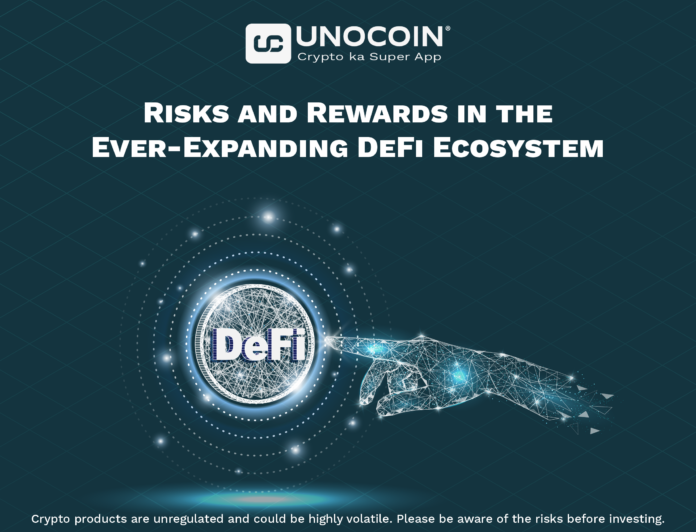Decentralized Finance 2.0: Navigating the Ever-Evolving Landscape
The decentralized finance (DeFi) space is going through a phase of transformation marked by the arrival of DeFi 2.0. In this blog, we’ll explore the latest protocols and developments that define this new era, and shed light on the risks and rewards of the ever-expanding DeFi ecosystem.
Evolution of DeFi 2.0:
Layer 2 solution:
DeFi 2.0 brings improved scalability through a Layer 2 solution and addresses throughput issues that plagued earlier iterations. Projects like Optimistic Rollups and zk-Rollups are coming to the fore, promising faster and more cost-effective transactions.
Cross-chain compatibility:
Interoperability is a key theme in DeFi 2.0. Protocols are now designed to work seamlessly across different blockchains, supporting collaboration and expanding the scope of decentralized finance beyond individual networks.
Smart Contract Upgrades:
DeFi 2.0 introduces more sophisticated smart contract features that enable complex financial tools and decentralized applications (DApps). These upgraded contracts increase security and offer a wider range of features.
Risks in DeFi 2.0:
Smart Contract security flaws:
The increased complexity of smart contracts in DeFi 2.0 brings with it the potential for vulnerability. Developers and users must remain vigilant to mitigate the risks associated with coding errors or exploits.
Regulatory uncertainty:
The evolving regulatory landscape poses challenges for DeFi platforms. Navigating compliance issues becomes critical as governments around the world seek to define their stance on decentralized finance.
Market Volatility:
DeFi assets remain sensitive to market volatility. Understanding the risks associated with price fluctuations is essential for users and investors participating in decentralized finance.
Rewards and Opportunities:
Improved user experience:
DeFi 2.0 prioritizes user experience, making decentralized finance more accessible to everyday users. Improved interfaces, reduced transaction costs and faster confirmation times contribute to a more user-friendly environment.
Increased financial inclusion:
DeFi development aims to bridge the gaps of traditional financial systems and provide financial services to unbanked and underserved populations worldwide. This is in line with the core ethos of decentralized finance – creating a more inclusive financial ecosystem.
Innovative financial products:
DeFi 2.0 opens the door to innovative financial products and services. Revenue farming, liquidity provision, and decentralized exchanges continue to evolve, offering users new ways to earn and work with their assets.
Conclusion:
Decentralized Finance 2.0 represents a promising chapter in the development of blockchain-based finance. While it brings exciting improvements, users and developers must be aware of the inherent risks. Navigating the complexities of DeFi 2.0 requires a balanced approach that embraces innovation while keeping a close eye on security and regulatory aspects.
As the DeFi landscape continues to evolve, staying informed about the latest protocols and staying adaptable will be key to unlocking the full potential of decentralized finance in this new era.
Please find the list of authentic Unocoin accounts for all your queries below:
- YouTube Channel: https://www.youtube.com/c/Unocoin/videos
- Newsletter: https://medium.com/subscribe/@Unocoin_growth
- Blogs: https://blog.unocoin.com
- Instagram: https://www.instagram.com/unocoin/
- Twitter: https://twitter.com/Unocoin
- Facebook: https://www.facebook.com/unocoin/
- LinkedIn: https://in.linkedin.com/company/unocoin
- Telegram Group: https://t.me/Unocoin_Group
- Telegram Channel: https://t.me/+fasQhTKBsfA5N2Zl
- Telegram: https://t.me/UnocoinSupport_Bot
- E-mail id: [email protected]
- Contact details: 7788978910 (09:30 AM IST – 06:30 PM, Mon – Sat)
- App store link: https://apps.apple.com/us/app/unocoin/id1030422972?ls=1
- Playstore link: https://play.google.com/store/apps/details?id=com.unocoin.unocoinwallet
Disclaimer: Crypto products are unregulated as of this date in India. They could be highly volatile. At Unocoin, we understand that there is a need to protect consumer interests as this form of trading and investment has risks that consumers may not be aware of. To ensure that consumers who deal in crypto products are not misled, they are advised to DYOR (Do Your Own Research).




